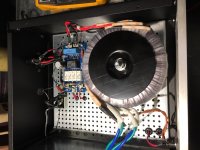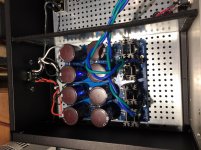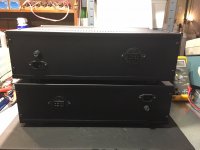Thank you Scott, good advise. That is the best explanation I've read, I don't have much experience with Class A amplifiers. My plan is to put the CRC board on stilts so they are as close as possible to the amp boards. This will leave 6" below the board open.
elwood625:
In my case, there was enough height in the enclosures to mount the power supply board on standoffs above the 1kw transformer; that left room on the floor of the chassis, which is where the third capacitor stage was mounted. I believe (but cannot prove) that the other advantage of locating the power supply board above the transformer is improved ventilation. Regardless, you'll undoubtedly be fine whether you mount the power supply board above or adjacent to (and above) the transformer. Don't let me sway you on positioning, as I am no expert.
Regards,
Scott
I'm using remote power supplies for the mono blocks, here is one of them. I finished the power supplies using diy store enclosures and the diy power supply boards. I'm using 8 pin Jones connectors for the umbilical cables.
Attachments
I rewired my whole amp, tried to keep all the signal connections as short as possible and as far away from transformer and PSU as possible...Nelson mentioned that cascodes can oscillate, and suggested a 100 Ohm resistor inline with each jfet drain to control that.
I also have the same issue, but have not yet corrected it -- my amp is still in rewiring mode....
Problem gone
But now I see a slight oscillation around 24kHZ on both channels, didn't notice it before, but square wave looks good now...
Last edited:
I rewired my whole amp, tried to keep all the signal connections as short as possible and as far away from transformer and PSU as possible...
Problem gone. Might have been some parasitic currents.
But now I see a slight oscillation around 24kHZ on both channels, didn't notice it before, but square wave looks good now...
So your bias measures the same with/without shorting plugs?
Yes, bias is about the sam. My offset is just different - about 20-30mV lower if open as i recall. What bothers me is that the bias between N and P boards differ up to 80mV (eg. 300mV P channel and 380mV N channel. I might buy some mosfets and match them myself.
How big is your bias drift?
How big is your bias drift?
I understand... We had 38°C the last two days here...
Listening today for the first time after reworking all the wiring from scratch... Very astonished that the sound became more clear, dynamic and with added depth. I'm still not sure what was wrong before. I'm more than happy now and could not imagine such a big positive effect on SQ.
Listening today for the first time after reworking all the wiring from scratch... Very astonished that the sound became more clear, dynamic and with added depth. I'm still not sure what was wrong before. I'm more than happy now and could not imagine such a big positive effect on SQ.
I'm preparing to make a pair of F5 Turbo V3 monoblocks in the 5U Chassis for a friend. He has a standard F5 now and loves it, but he wants more power for his speakers. Plus he's a Monoblock kind of guy. He likes the idea of 100W, but we can go a little conservative if we need to.
After lots of reading, I've taken the BOM PDF and made a spreadsheet to include all the parts for my friend to buy. The boards and components, chassis and components, PSU bits, resistors for Mosfet test jig.
I'm planning to use:
600VA Antek 2x35V Transformer per channel
CLC Power supply using Hammond 159ZL chokes (2.5MH / 10A / 0R044) and 8x 22,000uF / 63V caps per channel
I'm getting a large batch of IRFP9240 & IRFP240 to match for a total of 2 quads of each. I'll kit up extras in quads / pairs / singles when the matching is done. Per Jim 6L6's advice I'm getting more P's than N's based on how well they tend to match.
2SC4793 & 2SA1837 are now available from Digikey - I'm also getting extras to kit up with the Mosfets
I'll use the store PSU boards, and will implement snubbers using my quasimodo test jig to set snubber R.
Any comments to any of the above?
A few questions on the JFET's
Will I need 1 matched pair of 2SJ74 + 2SK170 per Monoblock (2 matched pairs total)? Or will I need parallel 2SJ74 + 2SK170's per monoblock (two matched Quads total)?
I'm looking at Punkydawgs offerings, what should target Idss be? He has some 10mA and 7-8mA range?
After lots of reading, I've taken the BOM PDF and made a spreadsheet to include all the parts for my friend to buy. The boards and components, chassis and components, PSU bits, resistors for Mosfet test jig.
I'm planning to use:
600VA Antek 2x35V Transformer per channel
CLC Power supply using Hammond 159ZL chokes (2.5MH / 10A / 0R044) and 8x 22,000uF / 63V caps per channel
I'm getting a large batch of IRFP9240 & IRFP240 to match for a total of 2 quads of each. I'll kit up extras in quads / pairs / singles when the matching is done. Per Jim 6L6's advice I'm getting more P's than N's based on how well they tend to match.
2SC4793 & 2SA1837 are now available from Digikey - I'm also getting extras to kit up with the Mosfets
I'll use the store PSU boards, and will implement snubbers using my quasimodo test jig to set snubber R.
Any comments to any of the above?
A few questions on the JFET's
Will I need 1 matched pair of 2SJ74 + 2SK170 per Monoblock (2 matched pairs total)? Or will I need parallel 2SJ74 + 2SK170's per monoblock (two matched Quads total)?
I'm looking at Punkydawgs offerings, what should target Idss be? He has some 10mA and 7-8mA range?
I'm preparing to make a pair of F5 Turbo V3 monoblocks in the 5U Chassis for a friend. He has a standard F5 now and loves it, but he wants more power for his speakers. Plus he's a Monoblock kind of guy. He likes the idea of 100W, but we can go a little conservative if we need to.
After lots of reading, I've taken the BOM PDF and made a spreadsheet to include all the parts for my friend to buy. The boards and components, chassis and components, PSU bits, resistors for Mosfet test jig.
I'm planning to use:
600VA Antek 2x35V Transformer per channel
CLC Power supply using Hammond 159ZL chokes (2.5MH / 10A / 0R044) and 8x 22,000uF / 63V caps per channel
I'm getting a large batch of IRFP9240 & IRFP240 to match for a total of 2 quads of each. I'll kit up extras in quads / pairs / singles when the matching is done. Per Jim 6L6's advice I'm getting more P's than N's based on how well they tend to match.
2SC4793 & 2SA1837 are now available from Digikey - I'm also getting extras to kit up with the Mosfets
I'll use the store PSU boards, and will implement snubbers using my quasimodo test jig to set snubber R.
Any comments to any of the above?
A few questions on the JFET's
Will I need 1 matched pair of 2SJ74 + 2SK170 per Monoblock (2 matched pairs total)? Or will I need parallel 2SJ74 + 2SK170's per monoblock (two matched Quads total)?
I'm looking at Punkydawgs offerings, what should target Idss be? He has some 10mA and 7-8mA range?
Rhthatcher:
I have a pair of F5T V3 mono blocks, and I’d offer three suggestions: first, use the 5U / 400mm deep Deluxe enclosures; second, use a bigger transformer — 800VA or 1000 VA would be better; and third, if 27,000 uF 63V caps are available, go for them instead of the 22,000 uF ones you’ve selected.
The 400mm deep chassis provides enough room to spread things out and still leaves room for expansion should it be needed (e.g., space to expand your friend’s power supplies to CLCRC should he want it). There’s room in the chassis for the bigger toroid; more oomph won’t hurt. And while 176,000 uF in capacitance per chassis exceeds NP’s model power supply, my experience is that the V3s respond well to a little more power.
YMMV.
Regards,
Scott
Any advice on what to get for F5 Turbo V3 JFets?
Will I need 1 matched pair of 2SJ74 + 2SK170 per Monoblock (2 matched pairs total)? Or will I need parallel 2SJ74 + 2SK170's per monoblock (two matched Quads total)?
I'm looking at Punkydawgs offerings, what should target Idss be? He has some 10mA and 7-8mA range?
Will I need 1 matched pair of 2SJ74 + 2SK170 per Monoblock (2 matched pairs total)? Or will I need parallel 2SJ74 + 2SK170's per monoblock (two matched Quads total)?
I'm looking at Punkydawgs offerings, what should target Idss be? He has some 10mA and 7-8mA range?
Mine were at the very bottom of the range at 6ma IIRC. That meant I had to change out a resistor in order to get enough adjustment range to get the bias current I want. 8 -10ma should be about right.
I built V3 monoblocks with separate power CLC power supplies. They are fantastic amps and have been trouble free for 2 years now. I’m running about 46 volt supplies and about 2,1 amps total bias. I recently measured the power out and it was just over 400w at 2 ohms. That is without the output stage diodes in the circuit.
I built V3 monoblocks with separate power CLC power supplies. They are fantastic amps and have been trouble free for 2 years now. I’m running about 46 volt supplies and about 2,1 amps total bias. I recently measured the power out and it was just over 400w at 2 ohms. That is without the output stage diodes in the circuit.
Max Class A bias watts
This has probably been explained previously here somewhere but I could not find.
How do I figure out the maximum output class A power output based on the source resistor bias voltage?
I understand that I have set the bias at .350 V across .5 ohms. 700ma.
I also know that I have 2 pair of output devices in parallel.
Ideally both pairs will be biased the same at 700ma ea for a total of 1.4 amps bias with a 32 V power supply. Now what?
This has probably been explained previously here somewhere but I could not find.
How do I figure out the maximum output class A power output based on the source resistor bias voltage?
I understand that I have set the bias at .350 V across .5 ohms. 700ma.
I also know that I have 2 pair of output devices in parallel.
Ideally both pairs will be biased the same at 700ma ea for a total of 1.4 amps bias with a 32 V power supply. Now what?
I think I got it.
2.7 A peak times .707 = 2 A rms
I squared x r = 4 Amp rms x 8 ohm = 32 W Class A
Peak current is 2.8. Average is 1/2 Peak.
Peak Voltage that the amp can deliver is rail voltage -- likely a bit less due to sagging.
This does NOT mean that the current of 2.8 amps happens at clipping!
Since V = IR, the voltage when the amp leaves class A when driving an 8 ohm speaker is 8*2.8 = 22.4 V. It is half that when driving 4 ohms, since current doubles into 4 ohms.
When providing more than 22.4 Volts to an 8 ohm speaker, the amp is operating in Class B.
- Home
- Amplifiers
- Pass Labs
- F5 Turbo Builders Thread


